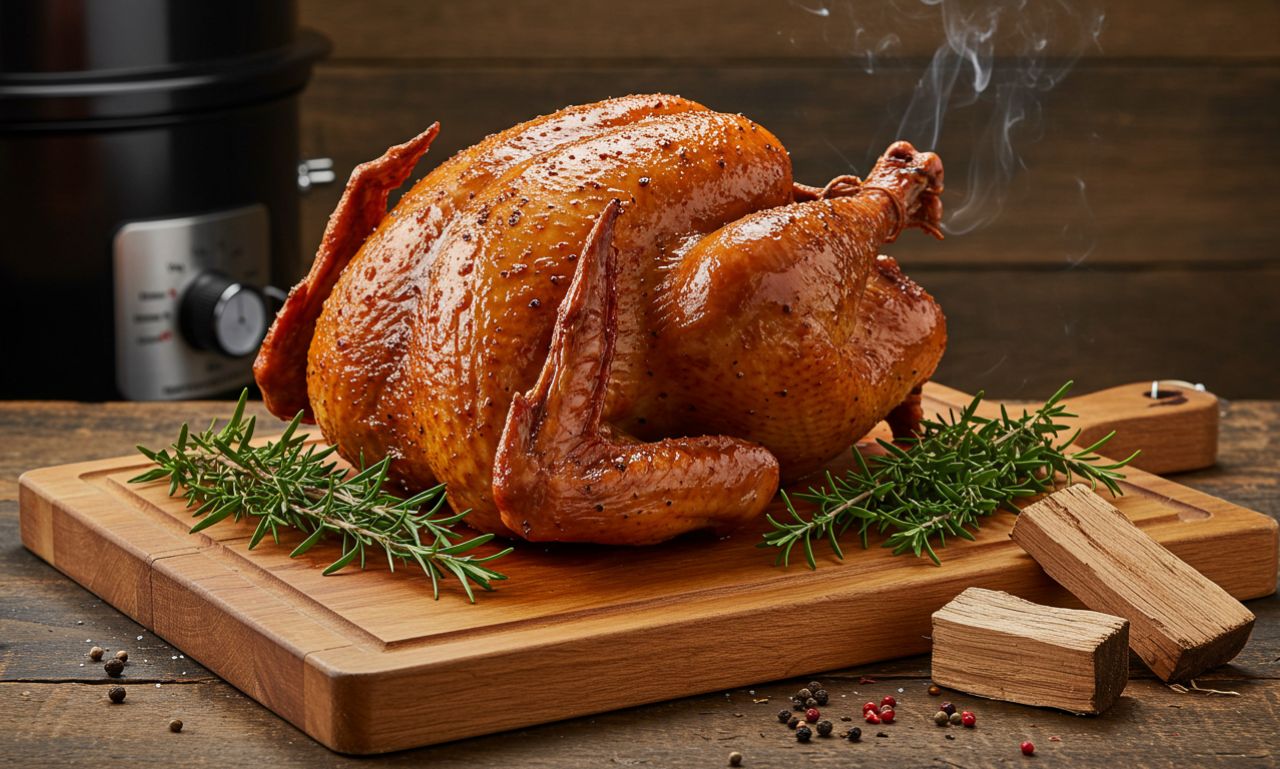For many families and food enthusiasts, smoking a turkey has become one of the most rewarding ways to prepare this traditional bird. The slow cooking process infuses the meat with rich, smoky flavors while keeping it tender and juicy. Whether for Thanksgiving, Christmas, or a summer barbecue, smoked turkey offers a mouthwatering alternative to oven-roasted or fried versions.
This guide dives into everything you need to know about smoking a turkey, from preparation and seasoning to wood selection, temperature control, and serving tips.
Smoking a Turkey: Why It’s Worth the Effort
Unlike traditional roasting, smoking a turkey brings depth and complexity to its flavor. The process allows the bird to absorb smoke from carefully chosen wood chips, giving each bite a distinctive aroma.
Benefits include:
-
Juicy meat: Low, slow cooking locks in moisture.
-
Enhanced flavor: Smoke combines with seasoning for bold results.
-
Versatility: Works with whole turkeys, turkey breasts, or legs.
-
Celebratory appeal: Perfect for holidays and outdoor feasts.
Once you experience the results of smoking a turkey, it’s hard to go back to simpler methods.
Preparing a Turkey for Smoking
Preparation is crucial for success. Follow these steps:
-
Choose the right turkey: Aim for birds between 10–14 pounds. Larger turkeys can take too long to smoke and risk uneven cooking.
-
Thaw properly: If frozen, thaw in the refrigerator, allowing 24 hours for every 4–5 pounds.
-
Brining: Soak in a salt-water solution (optionally with sugar, herbs, and spices) for 12–24 hours. This ensures moist, flavorful meat.
-
Pat dry: After brining, dry thoroughly to help the skin crisp.
-
Season generously: Apply a rub of salt, pepper, garlic, paprika, or custom spice blends.
Proper preparation ensures even cooking and full absorption of smoky flavor.
Smoking a Turkey: Wood Choices That Matter
The wood you choose shapes the final taste. Popular options include:
-
Applewood: Mild, slightly sweet smoke ideal for poultry.
-
Cherry: Adds subtle fruitiness and a dark color to the skin.
-
Hickory: Strong, bold flavor, best used sparingly.
-
Maple: Smooth and sweet for balanced results.
-
Pecan: Rich, nutty aroma that pairs perfectly with turkey.
Many pitmasters blend woods for unique flavor profiles, like apple and cherry or hickory and pecan.
Temperature and Timing for Smoking a Turkey
The golden rule of smoking a turkey is low and slow.
-
Smoker temperature: Maintain 225°F to 250°F.
-
Cooking time: Plan 30–40 minutes per pound.
-
Internal temperature: Turkey is safe when the thickest part of the breast reaches 165°F, and thighs reach 175°F.
Using a digital meat thermometer ensures accuracy and safety.
Smoking a Turkey: Step-by-Step Process
-
Preheat smoker to 225°F with your chosen wood.
-
Prepare the turkey by applying oil or butter under and over the skin for crispness.
-
Place the turkey in the smoker breast-side up.
-
Monitor temperature throughout, adding wood chips as needed.
-
Baste occasionally with butter, broth, or apple cider for moisture.
-
Check doneness using a thermometer, not just by time.
-
Rest before carving: Let the turkey sit 20–30 minutes before slicing to retain juices.
This careful process yields a flavorful, golden-brown bird.
Seasoning and Rub Ideas for Smoked Turkey
The beauty of smoking lies in flavor creativity. Popular rubs include:
-
Classic BBQ Rub: Paprika, garlic powder, onion powder, black pepper, brown sugar.
-
Herb Blend: Rosemary, thyme, sage, and oregano for a traditional holiday flavor.
-
Spicy Kick: Chili powder, cayenne pepper, and smoked paprika for heat lovers.
-
Citrus Zest Rub: Lemon or orange zest with garlic for a fresh twist.
Experiment to match the occasion and your taste preferences.
Stuffing and Filling Tips for Smoking a Turkey
Unlike roasting, it’s best to avoid stuffing the turkey when smoking. The dense filling can prevent even cooking and pose food safety risks. Instead:
-
Cook stuffing separately in the oven.
-
Use aromatics inside the cavity, such as onions, garlic, citrus, or herbs, to enhance flavor.
-
Add apples or celery to infuse moisture and subtle sweetness.
This approach ensures safety while still boosting taste.
Smoking a Turkey for Holidays and Events
Holiday meals take on a special charm when the turkey comes off the smoker. The aroma alone excites guests, and the results impress both traditionalists and adventurous eaters.
For Thanksgiving or Christmas, pair smoked turkey with:
-
Mashed potatoes and gravy
-
Cranberry sauce
-
Roasted vegetables
-
Fresh bread or rolls
In summer, smoked turkey shines alongside grilled corn, coleslaw, and baked beans.
Common Mistakes When Smoking a Turkey
Even experienced cooks sometimes make missteps. Avoid these pitfalls:
-
Choosing oversized turkeys: Birds over 14 pounds may not cook evenly.
-
Skipping brining: Results in dry meat.
-
Opening the smoker too often: Causes heat loss and longer cook times.
-
Not resting the turkey: Leads to dry slices.
Patience and precision are key to success.
Health Benefits of Smoking Turkey
Surprisingly, smoked turkey can be healthier than fried or heavily buttered roasted versions. Benefits include:
-
Lower fat content when the skin is removed.
-
Rich in protein, supporting muscle and energy.
-
Less oil is needed compared to deep frying.
-
Nutrient retention thanks to slow cooking.
For health-conscious families, smoking a turkey offers a balanced mix of indulgence and nutrition.
Storing and Reusing Smoked Turkey
Leftovers are almost as exciting as the main meal. Store safely by:
-
Refrigerating within two hours of cooking.
-
Keep in airtight containers for 3–4 days.
-
Freeze portions for up to three months.
Creative uses include turkey sandwiches, soups, casseroles, or smoked turkey salads.
Smoking Turkey: Looking Ahead
As backyard cooking grows more popular, smoking techniques are being refined with modern tools and smart devices. Digital smokers, Bluetooth thermometers, and pellet grills simplify the process, making smoking accessible to beginners.
The rising interest in outdoor cooking ensures smoked turkey will remain a star at gatherings, blending tradition with innovation.
Conclusion
Smoking a turkey is more than a cooking method—it’s an experience that brings people together around rich aromas and unforgettable flavors. By selecting the right turkey, preparing it carefully, choosing suitable wood, and managing temperature, anyone can master this art.
With patience and creativity, smoked turkey can become the highlight of your holiday table, summer barbecue, or family feast.

